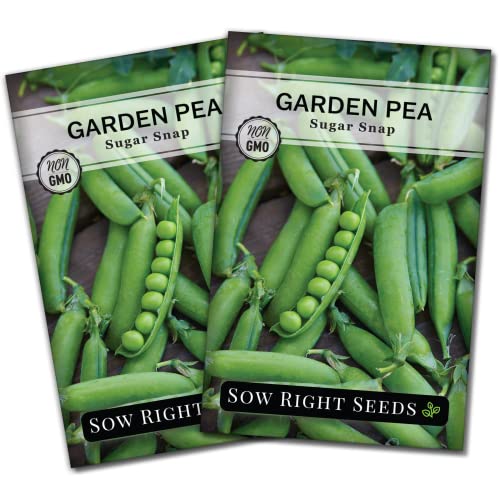Introduction
Hydroponics is revolutionizing modern agriculture, offering a sustainable, space-efficient alternative to traditional soil-based farming. This soilless growing method enables year-round production with up to 90% less water usage while delivering faster growth rates and premium-quality produce.
Whether you’re an established farmer looking to diversify, an entrepreneur seeking profitable agricultural opportunities, or a sustainability advocate interested in innovative food production, hydroponics presents compelling advantages worth exploring. This comprehensive guide walks you through everything from basic concepts to building a profitable hydroponic vegetable operation.
With urban agriculture gaining momentum and consumer demand for locally-grown, pesticide-free produce reaching new heights, now is an ideal time to enter the hydroponics market. Let’s explore how this technology can transform your agricultural ambitions into reality.
What is Hydroponics?
Hydroponics is a cultivation technique where plants grow without soil, receiving essential nutrients directly through water-based solutions. Instead of drawing nutrition from earth, plant roots are suspended in, flooded with, or misted by nutrient-enriched water carefully formulated to support optimal growth.
This controlled environment approach allows growers to precisely manage every aspect of plant nutrition, delivering exactly what plants need at each growth stage. The result is faster maturation, higher yields, and consistent quality that traditional farming struggles to match.
The Science Behind Soilless Growing
In conventional agriculture, soil serves three primary functions: anchoring roots, storing water, and providing nutrients. Hydroponics replaces soil with inert growing media (like perlite, coconut coir, or clay pebbles) or suspends roots directly in nutrient solution, fulfilling these functions more efficiently.
Plants grown hydroponically allocate less energy to root development searching for nutrients and water, instead channeling resources toward vegetative growth and fruit production. This efficiency explains why hydroponic lettuce can mature in 30-35 days compared to 45-60 days in soil.
Key Components of Hydroponic Systems:
- Nutrient solution (water + mineral fertilizers)
- Growing medium (optional, depending on system)
- Oxygen delivery to roots
- pH and electrical conductivity (EC) management
- Light (natural sunlight or LED grow lights)
- Climate control (temperature and humidity)
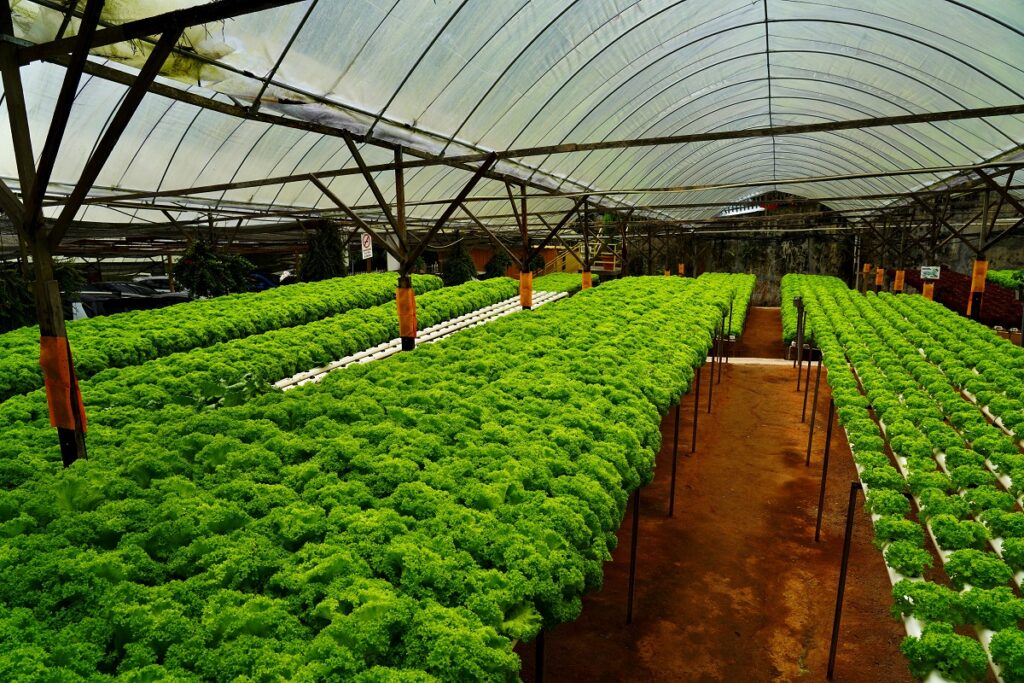
Why Invest in Hydroponics? Key Business Advantages
Hydroponics offers compelling benefits that translate directly into business opportunities, particularly for operations near urban markets or regions with limited arable land.
Water Conservation
Hydroponic systems use 80-90% less water than conventional agriculture through recirculation and precise delivery. In a closed system, plants take only what they need, with excess solution returning to the reservoir. This efficiency is crucial in water-scarce regions and increasingly appeals to sustainability-conscious consumers.
For perspective, producing one head of lettuce in soil requires approximately 3-4 gallons of water, while hydroponics needs just 0.3-0.4 gallons for the same result.
Year-Round Production
Unlike field farming dependent on seasons and weather, controlled environment hydroponics enables continuous production regardless of external conditions. This consistency means:
- Stable income throughout the year
- No seasonal income gaps
- Ability to meet consistent supply contracts with retailers and restaurants
- Protection from climate-related crop failures
In regions with harsh winters, indoor hydroponics transforms what would be dormant months into productive, profitable periods.
Superior Space Efficiency
Vertical hydroponic systems can produce 10-20 times more per square foot than traditional farming. A 1,000-square-foot greenhouse can yield what requires several acres of conventional farmland.
This density makes hydroponics particularly viable for:
- Urban and peri-urban locations where land costs are prohibitive
- Rooftop farming operations
- Warehouse conversions
- Small properties maximizing production value
Faster Growth and Higher Yields
Optimized nutrient delivery and environmental control accelerate plant development by 25-50%. Faster turnover means more crop cycles annually and increased revenue from the same infrastructure.
Comparison Example:
- Soil-grown lettuce: 45-60 days, 2-3 harvests per year
- Hydroponic lettuce: 30-35 days, 8-10 harvests per year
Premium Product Quality
Hydroponic vegetables grown without soil contact and pesticides command premium prices at farmers’ markets, specialty grocers, and restaurants. The controlled environment produces:
- Cleaner produce requiring minimal washing
- Consistent size and appearance
- Extended shelf life (roots-on lettuce stays fresh 2-3 weeks)
- Better nutritional profiles in some cases
Growing Market Demand
Consumer trends strongly favor hydroponic products. The US organic and local food market continues expanding, with hydroponic produce fitting perfectly into this niche. Key market drivers include:
- Health-conscious consumers seeking pesticide-free options
- Restaurant demand for fresh, locally-sourced ingredients
- Urban populations wanting connection to food sources
- Sustainability concerns about water usage and food miles
The global hydroponics market, valued at approximately $10 billion in 2023, is projected to reach $20+ billion by 2030, reflecting robust growth opportunities.
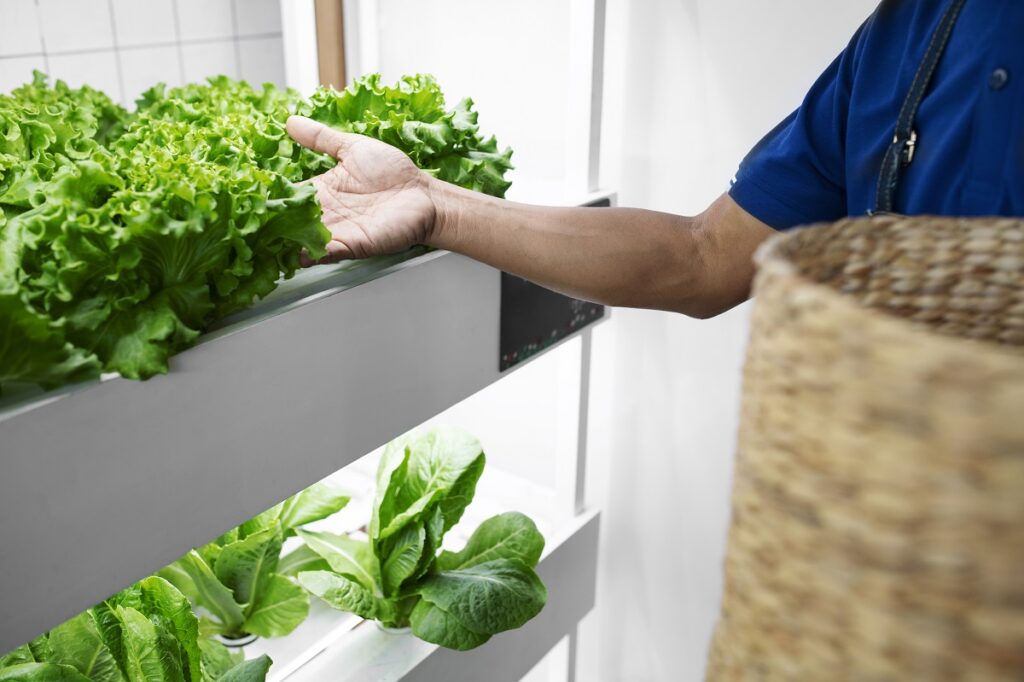
Types of Hydroponic Systems for Vegetable Production
Selecting the right system depends on your crops, scale, budget, and technical expertise. Here are the most popular systems for commercial vegetable production.
1. NFT (Nutrient Film Technique)
The most widely adopted commercial system, NFT circulates a thin film of nutrient solution through slightly tilted channels, allowing plant roots to absorb nutrients while exposed to oxygen.
Best for: Leafy greens (lettuce, arugula, spinach, kale), herbs (basil, cilantro, mint)
Advantages:
- Simple design with minimal growing media
- Easy harvesting and replanting
- Excellent oxygenation for roots
- Scalable for large operations
- Lower labor costs
Considerations:
- Vulnerable to pump failures (roots dry quickly without flow)
- Requires backup power systems
- Not ideal for large-fruiting plants
- Needs regular channel cleaning
Typical Setup: PVC pipes or specialized channels set at 1-2% slope with continuous nutrient flow powered by submersible pumps.
2. Deep Water Culture (DWC) / Floating Raft System
Plants float on foam boards atop deep tanks of oxygenated nutrient solution, with roots submerged directly in the water.
Best for: Lettuce, leafy greens, herbs
Advantages:
- Extremely stable (large water volume buffers pH and EC fluctuations)
- Simple construction and maintenance
- Beginner-friendly
- Lower risk of crop failure from system malfunctions
- Excellent for commercial lettuce production
Considerations:
- Requires air pumps and air stones for oxygenation
- Heavy (water-filled tanks difficult to move)
- Less suitable for plants with varying water needs
- Potential for root disease if oxygenation fails
Commercial Application: This system dominates large-scale lettuce production, with operations growing thousands of heads simultaneously in warehouse settings.
3. Drip Irrigation Hydroponics
Nutrient solution drips onto plants rooted in inert substrate (coconut coir, perlite, rockwool, or expanded clay), with excess solution either recirculated (closed system) or drained (open system).
Best for: Tomatoes, cucumbers, peppers, strawberries, larger plants
Advantages:
- Versatile for various plant sizes
- Precise control over watering frequency
- Suitable for fruiting vegetables
- Can use widely available irrigation components
- Flexible media choices
Considerations:
- Requires quality substrate
- More complex plumbing
- Regular emitter cleaning needed
- Higher media costs
System Variations:
- Recirculating: Solution returns to reservoir (water-efficient)
- Run-to-waste: Excess drains away (simpler but less sustainable)
4. Vertical Tower Systems
Plants grow in stacked towers or columns, maximizing vertical space with nutrient solution dripping down through the structure.
Best for: Strawberries, leafy greens, herbs, small fruiting vegetables
Advantages:
- Maximum space efficiency (30-50% more production per square foot)
- Reduced bending and stooping during harvest
- Eye-catching for agritourism operations
- Ideal for limited floor space
Considerations:
- Higher initial investment
- More complex assembly
- Uneven nutrient distribution if not properly designed
- Requires structural support
5. Ebb and Flow (Flood and Drain)
Growing trays periodically flood with nutrient solution before draining back to a reservoir, cycling multiple times daily.
Best for: Various vegetables, experimental setups, smaller operations
Advantages:
- Excellent root oxygenation between floods
- Works with many plant types
- Automated timing systems
- Flexible tray configurations
Considerations:
- Timer and pump reliability critical
- More components that can fail
- Regular system checks needed
How to Start a Hydroponic Vegetable Business: Step-by-Step Guide
Launching a profitable hydroponics operation requires careful planning, technical knowledge, and business acumen. Follow this roadmap to build your venture from concept to revenue.
Step 1: Market Research and Business Planning
Before investing capital, thoroughly understand your market and create a solid business foundation.
Identify Your Target Market:
Who will purchase your produce? Each channel has different requirements and profit margins:
- Farmers’ markets: Highest retail prices ($4-8 per lettuce head), direct customer relationships, weekend commitment required
- Restaurants and chefs: Premium pricing for consistent quality, weekly delivery schedules, smaller volumes
- Grocery stores and food co-ops: Larger volumes, lower per-unit prices, need liability insurance and food safety certifications
- CSA (Community Supported Agriculture) boxes: Subscription model provides predictable income, requires diverse crop selection
- Direct-to-consumer delivery: High margins, marketing intensive, requires online presence and logistics
Conduct Competitive Analysis:
Visit local markets and survey potential buyers to understand:
- Current pricing for hydroponic vs. conventional produce
- Most in-demand crops and varieties
- Packaging expectations
- Delivery requirements
- Seasonal demand fluctuations
Choose Your Crop Focus:
Start with 2-4 crops rather than attempting wide variety. Most profitable beginner options:
- Lettuce varieties (butterhead, romaine, red leaf): Fast turnover, consistent demand
- Herbs (basil, cilantro, mint): High value per pound, strong restaurant demand
- Leafy greens (arugula, kale, spinach): Growing health food market
- Specialty crops (microgreens, edible flowers): Premium pricing, niche markets
Get Technical Education:
Invest in your knowledge before equipment:
- Online courses from universities (Cornell CEA program, University of Arizona)
- Industry conferences (Indoor AgCon, Cultivate)
- Books on hydroponic vegetable production
- YouTube channels and podcasts from successful growers
- Mentorship from established operations
- Hydroponic supplier workshops
Understand Legal Requirements:
Required permits and registrations vary by state and locality:
- Business license and registration (LLC, sole proprietorship, etc.)
- Agricultural exemption or farm status (for tax benefits)
- Food safety certification (such as GAP – Good Agricultural Practices)
- Liability insurance (especially for wholesale customers)
- Cottage food or processing licenses (if adding value like salad mixes)
- Water usage permits (in some jurisdictions)
- Building permits (for greenhouse or structure construction)
Develop Your Business Plan:
Include financial projections, marketing strategy, operational timeline, and growth plans. This document is essential for securing financing and guiding decisions.
Step 2: Infrastructure and System Setup
With planning complete, design and build your growing infrastructure tailored to your crops and scale.
Greenhouse or Growing Structure:
Protecting crops from weather extremes is essential for consistent production.
Structure Options:
- High tunnels: Unheated hoop houses with manual ventilation, most economical ($3-7 per sq ft)
- Greenhouses: Climate-controlled with automated systems, higher production ($10-30 per sq ft)
- Indoor facilities: Warehouses with complete environmental control and LED lighting, highest cost ($50-150 per sq ft)
- Shade houses: Structures with shade cloth for hot climates
Climate Control Systems:
- Ventilation fans and intake shutters
- Evaporative cooling (for arid regions)
- Supplemental heating (propane, natural gas, or electric)
- Shade curtains or retractable systems
- Humidity management
Location Considerations:
- Proximity to markets (reduce transport time and costs)
- Access to electricity and water
- Zoning compliance
- Flat, well-drained land
- Good road access for deliveries
Hydroponic System Components:
Essential Equipment:
- Growing channels, tanks, or towers (system-dependent)
- Nutrient solution reservoir (50-500 gallon capacity)
- Water pumps (with backup recommended)
- Irrigation timers or controllers
- Air pumps and air stones (for DWC systems)
- pH and EC meters for monitoring
- Growing media (if required by system type)
- Plant support structures
Nutrient Management:
- Commercial hydroponic fertilizers (two-part or three-part formulas)
- pH adjustment solutions (pH up/down)
- Water filtration if using well or questionable municipal water
Monitoring Equipment:
- Temperature and humidity sensors
- pH and EC controllers (automated dosing for larger operations)
- Backup power system (generator or battery backup for critical systems)
Image Suggestion 5: Greenhouse interior showing complete hydroponic setup
Alt Text: “Interior view of commercial hydroponic greenhouse with NFT channels, reservoir tanks, and climate control”
Step 3: Investment and Startup Costs
Understanding financial requirements prevents undercapitalization and allows realistic budgeting.
Home-Scale/Learning Setup ($2,000 – $5,000):
- Small greenhouse or high tunnel (100-200 sq ft)
- Basic NFT or DWC system
- Manual climate control
- Capacity: 200-500 plants
- Purpose: Learning system, market testing, part-time income
Small Commercial Operation ($15,000 – $35,000):
- 1,000-2,000 sq ft greenhouse
- Complete hydroponic system with automation
- Basic climate control
- Capacity: 1,500-3,000 plants
- Revenue potential: $20,000-50,000 annually
Medium Commercial Operation ($50,000 – $150,000):
- 3,000-8,000 sq ft greenhouse
- Advanced automation and monitoring
- Full climate control
- Multiple crop zones
- Capacity: 5,000-15,000 plants
- Revenue potential: $75,000-200,000 annually
Large Commercial Operation ($200,000+):
- 10,000+ sq ft or multiple structures
- Complete automation
- Sophisticated environmental controls
- Professional packaging and cooling facilities
- Capacity: 20,000+ plants
- Revenue potential: $300,000+ annually
Hidden Costs to Consider:
- Permits and inspections ($500-2,000)
- Insurance (liability, property) ($1,000-5,000 annually)
- Utilities (electricity for pumps, lighting, climate control)
- Seeds and starter materials (ongoing)
- Nutrients and supplies (ongoing)
- Marketing and packaging materials
- Transportation and delivery
- Unexpected repairs and replacements
Financing Options:
- USDA microloans (up to $50,000 for beginning farmers)
- Farm Service Agency (FSA) loans
- State agricultural development grants
- Local credit unions and banks
- Crowdfunding for community-supported ventures
- Self-funding with gradual expansion
Pro Tip: Start small and scale gradually. Many successful operations began with 500-1,000 square feet, using profits to expand rather than taking excessive initial debt.
Step 4: Production Operations
With infrastructure ready, implement efficient production systems for consistent quality and yield.
Propagation and Starting Plants:
Most commercial operations purchase seedlings from specialized propagators rather than starting from seed, saving 2-3 weeks and ensuring uniform quality.
Options:
- Purchase plugs or seedlings from hydroponic suppliers
- Start your own seeds in rockwool cubes or foam plugs
- Partner with local nurseries for custom propagation
Transplanting: Move seedlings to production systems when they have 2-3 true leaves and established roots.
Nutrient Management:
Proper nutrient solution management is critical for crop success.
Key Parameters:
- EC (electrical conductivity): Measures nutrient concentration
- Lettuce/leafy greens: 1.2-1.8 mS/cm
- Herbs: 1.5-2.0 mS/cm
- Fruiting crops: 2.0-3.0 mS/cm
- pH: Affects nutrient availability
- Optimal range: 5.5-6.5
- Check daily and adjust as needed
- Temperature: Nutrient solution should stay 65-75°F (18-24°C)
Daily Monitoring:
- Check pH and EC levels
- Inspect pumps and irrigation function
- Look for pest or disease signs
- Monitor plant growth and color
- Record environmental conditions
Weekly Tasks:
- Clean filters and check equipment
- Top off reservoir with fresh solution
- Adjust nutrient concentrations
- Deep clean harvest areas
Production Timing:
Lettuce (most popular crop):
- Propagation: 10-14 days
- Growing period: 25-35 days
- Total: 35-49 days seed to harvest
- Annual cycles: 8-10 harvests
Space Productivity Example:
- 1,000 sq ft greenhouse
- 2,000 lettuce heads per month
- $3 wholesale price per head
- Potential monthly revenue: $6,000
- Annual revenue: $72,000 (before expenses)
Step 5: Marketing and Sales Strategy
Growing quality produce is only half the equation; effective marketing converts harvest into revenue.
Branding and Positioning:
Develop a compelling brand that communicates your unique value proposition:
- Locally grown freshness
- Sustainable water use
- Pesticide-free production
- Year-round availability
- Superior quality and taste
Sales Channels:
Direct to Consumer:
- Farmers’ markets (highest margins, customer feedback)
- On-farm sales and u-pick events
- Online ordering with home delivery
- Subscription boxes (CSA model provides stable income)
Wholesale:
- Local restaurants and chefs (build relationships, consistent orders)
- Independent grocery stores (better margins than chains)
- Food co-ops (values-aligned customers)
- Institutional buyers (schools, hospitals, corporate cafeterias)
Marketing Tactics:
- Social media showcasing production process (Instagram, Facebook)
- Website with online ordering capability
- Email newsletters with recipes and farm updates
- Farm tours for customers and schools (builds loyalty)
- Partnerships with chefs for featured dishes
- Food blogger and media outreach
- Farmers’ market demonstrations
Packaging and Presentation:
Professional packaging commands premium prices:
- Clear clamshells showing product quality
- Custom labels with brand and growing information
- “Living lettuce” with roots attached (longer shelf life)
- Certification logos (organic, local, sustainable)
- QR codes linking to farm story or recipes
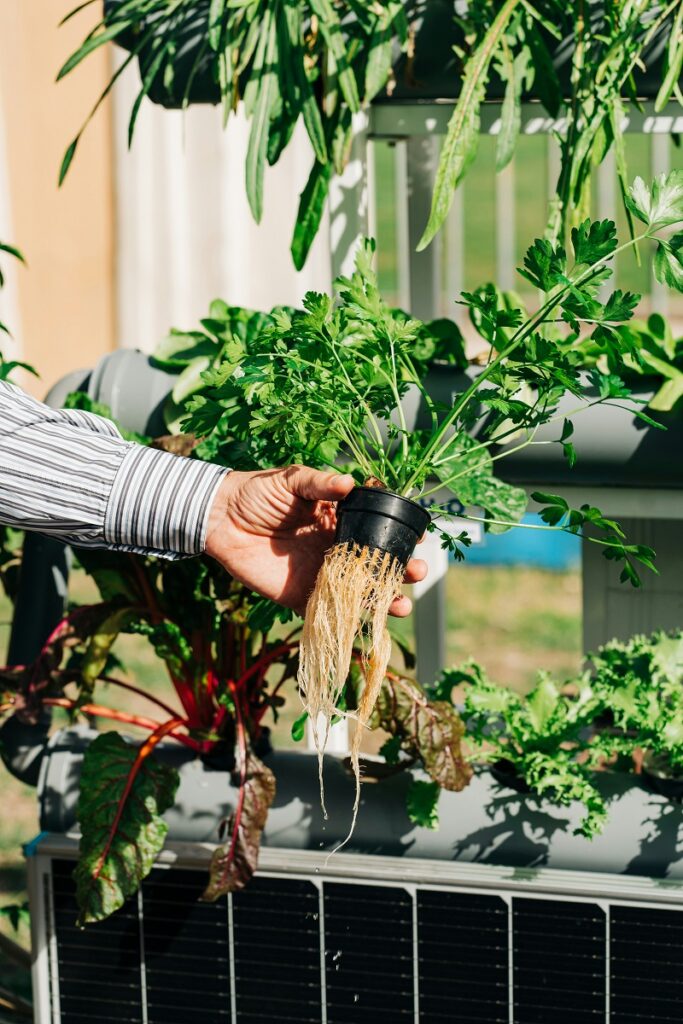
Is Hydroponics Profitable? Economic Reality Check
With proper planning and execution, hydroponic vegetable production can be highly profitable, but success requires understanding the economics.
Profit Drivers
Revenue Optimization:
- Premium pricing (20-40% above conventional produce)
- Direct sales eliminating middleman markups
- Year-round production maximizing facility utilization
- Fast crop turnover (8-10+ harvests annually)
- Multiple revenue streams (wholesale + retail)
Cost Management:
- Reduced water and fertilizer waste
- Lower labor costs per unit (efficient harvesting)
- Minimal crop loss from weather or soil-borne diseases
- Efficient space utilization
- Economies of scale as operations grow
Real-World Profitability Examples
Small Urban Farm (1,000 sq ft):
- Annual revenue: $40,000-60,000
- Operating expenses: $20,000-30,000
- Net profit: $15,000-30,000
- ROI: 30-60% after establishment year
Medium Commercial Operation (5,000 sq ft):
- Annual revenue: $150,000-250,000
- Operating expenses: $80,000-130,000
- Net profit: $50,000-100,000
- ROI: 35-65% after establishment year
Factors Affecting Profitability:
- Location and market access
- Growing efficiency and crop quality
- Sales channel mix (retail vs. wholesale)
- Management skill and experience
- Energy costs (significant in indoor operations)
- Competition from other local growers
Common Financial Pitfalls
- Undercapitalization (running out of funds before profitability)
- Overbuilding before mastering production
- Underpricing products (failing to capture premium value)
- Poor crop planning leading to gaps or gluts
- Inadequate working capital for ongoing expenses
- Ignoring marketing and sales development
Success Formula: Start conservatively, master production with one or two crops, build reliable customer base, then expand systematically using profits rather than debt.
Essential Tips for Hydroponic Success
Start Small and Scale Gradually
The greatest mistake new hydroponic farmers make is building too large too quickly. Begin with a manageable system that allows you to:
- Master technical skills without overwhelming complexity
- Learn your market’s preferences and timing
- Build customer relationships gradually
- Make mistakes at smaller financial scale
- Understand true operating costs
- Refine processes before major investment
A successful 500 square foot operation provides the foundation for confident expansion to 2,000+ square feet.
Focus on Crop Quality Over Quantity
Premium pricing comes from superior quality. Prioritize:
- Consistent sizing and appearance
- Excellent flavor and texture
- Freedom from defects or damage
- Proper post-harvest handling
- Professional presentation
One customer willing to pay premium prices for exceptional quality is worth more than multiple customers buying mediocre products cheaply.
Build Strong Customer Relationships
In local food markets, relationships drive long-term success:
- Communicate regularly with buyers
- Deliver consistently on time
- Respond quickly to feedback
- Be flexible with special requests
- Share your farm story and growing practices
- Involve customers in your operation (tours, events)
Invest in Ongoing Education
Hydroponics technology and best practices continually evolve. Stay current through:
- Industry publications and research
- Online forums and grower communities
- Workshops and conferences
- Networking with other farmers
- Experimentation with new varieties and techniques
Monitor and Optimize Continuously
Data-driven management improves profitability:
- Track crop performance (yield, quality, timing)
- Monitor financial metrics (cost per plant, revenue per square foot)
- Analyze customer preferences and buying patterns
- Test pricing strategies
- Identify efficiency improvements
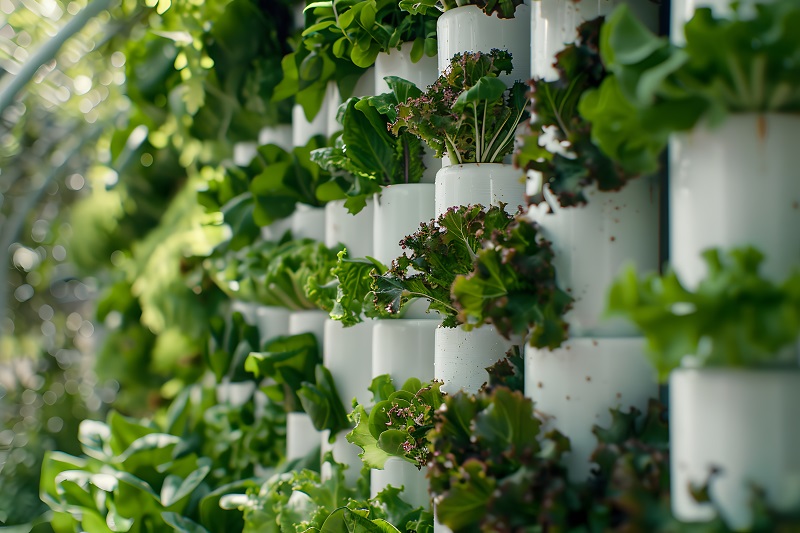
Sustainability and Environmental Impact
Hydroponics aligns perfectly with growing consumer demand for environmentally responsible food production.
Water Conservation: Using 80-90% less water than conventional agriculture makes hydroponics ideal for drought-prone regions and addresses increasing water scarcity concerns.
Reduced Chemical Use: Controlled environments minimize pest and disease pressure, dramatically reducing or eliminating pesticide needs. This appeals to health-conscious consumers and organic-oriented buyers.
Local Food Production: Growing near consumption areas reduces food miles, lowers carbon footprint from transportation, and delivers fresher products with better nutritional value.
Year-Round Production: Eliminating seasonal importing from distant regions reduces environmental impact while supporting local economies.
Land Efficiency: Producing more food per square foot preserves natural ecosystems and agricultural land for other purposes.
Marketing Advantage: Communicate these sustainability benefits prominently in your branding and customer education.
Common Challenges and Solutions
Challenge: System Failures and Technical Issues
Solutions:
- Install backup power systems for critical pumps
- Maintain spare parts inventory (pumps, timers, sensors)
- Implement monitoring systems with alerts
- Develop emergency protocols
- Regular preventive maintenance schedules
Challenge: Pest and Disease Management
Solutions:
- Implement strict sanitation protocols
- Use physical barriers (screens, air curtains)
- Monitor plants daily for early detection
- Employ integrated pest management (IPM) strategies
- Quarantine new plants before introduction
- Maintain optimal environmental conditions
Challenge: Market Competition and Pricing Pressure
Solutions:
- Differentiate through superior quality
- Build strong brand and customer loyalty
- Diversify sales channels
- Offer unique varieties not available elsewhere
- Focus on service and reliability
- Develop niche markets (restaurants, specialty stores)
Challenge: Consistent Quality and Production
Solutions:
- Standardize operating procedures
- Document and follow best practices
- Train staff thoroughly
- Monitor environmental parameters closely
- Keep detailed records for troubleshooting
- Adjust growing protocols seasonally
Future of Hydroponics: Industry Trends
The hydroponics industry continues evolving rapidly with exciting developments:
Automation and Technology: AI-powered monitoring, automated nutrient dosing, robotic harvesting, and precision agriculture tools are becoming more accessible and affordable.
Vertical Farming Integration: Multi-level growing systems maximize space efficiency in urban environments and warehouse conversions.
LED Lighting Advances: Improved efficiency and spectral optimization enable profitable indoor production in locations without suitable greenhouse light.
Renewable Energy: Solar panels and other renewable sources offset energy costs and enhance sustainability credentials.
Supply Chain Integration: Direct partnerships between growers and retailers or restaurants streamline distribution and improve margins.
Consumer Awareness: Growing understanding of hydroponic benefits drives demand and acceptance of premium pricing.
Frequently Asked Questions About Hydroponics
Is hydroponic produce as nutritious as soil-grown?
Research shows hydroponic vegetables have comparable or superior nutritional profiles to conventionally grown produce, depending on nutrient management and variety selection.
Can hydroponic crops be certified organic?
USDA organic certification for hydroponics remains controversial. While some operations have received certification, others cannot. However, terms like “pesticide-free,” “sustainably grown,” and “local” resonate strongly with target customers.
What crops are most profitable for hydroponics?
Leafy greens (lettuce, arugula), herbs (basil, cilantro), and specialty items (microgreens, edible flowers) typically offer the best margins and fastest turnover for beginning operations.
How much can I earn from a small hydroponic farm?
A well-managed 1,000 square foot operation can generate $30,000-60,000 in annual net profit after the establishment year, depending on crops, pricing, and sales channels.
What’s the biggest mistake new hydroponic farmers make?
Building too large too quickly without mastering production techniques, understanding markets, or securing reliable customers. Start small and scale based on proven demand.
Conclusion: Is Hydroponics Right for Your Agricultural Future?
Hydroponics represents an exciting convergence of sustainability, profitability, and innovation in modern agriculture. For entrepreneurs and farmers willing to embrace technology and sustainable practices, this growing method offers compelling advantages: water efficiency, space productivity, year-round income potential, and alignment with powerful consumer trends.
Success in hydroponic vegetable production requires more than just building a system—it demands technical knowledge, business acumen, market understanding, and commitment to quality. However, those who invest time in education, start conservatively, and focus on building customer relationships can build thriving operations that deliver fresh, premium produce to their communities while generating attractive returns.
The path forward is clear: start with careful planning and market research, build a right-sized system for learning and growth, master production with a focused crop selection, develop strong sales channels, and scale systematically based on proven demand and profitability.
Ready to start your hydroponic journey? Begin by visiting local operations, taking a course or workshop, connecting with your potential market, and developing your business plan. The opportunity to transform agriculture while building a sustainable business awaits.




